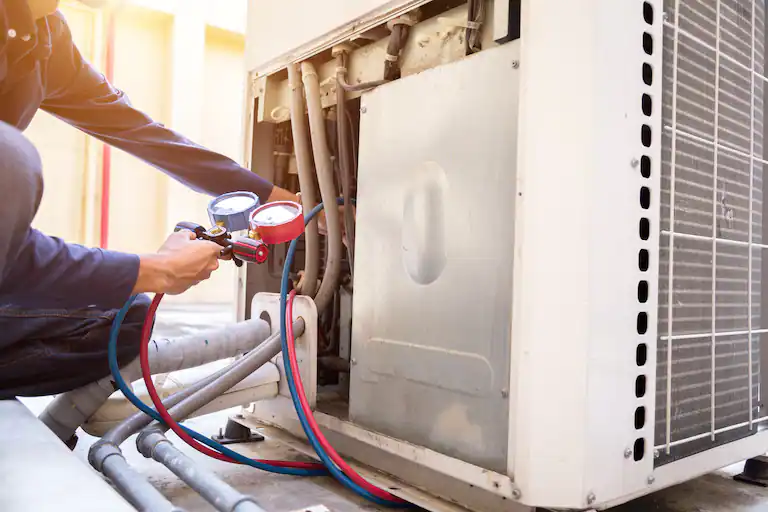Whether you’ve recently installed a new AC unit or are a seasoned homeowner, understanding the importance of air conditioning maintenance is key to enjoying optimal comfort in your living spaces.
A well-maintained system ensures consistent cooling during the scorching summer months and provides many benefits beyond mere temperature control. From improved energy efficiency and lower utility bills to enhanced indoor air quality and an extended system lifespan, proper AC maintenance can transform your home into an oasis of comfort and tranquility.
Our comprehensive guide will unveil the crucial steps and insider insights that will enable your new air conditioner to operate at the pinnacle of its performance, maximizing its advantages for countless years to come.
How to Keep Your AC Unit in Top Shape
When it comes to AC maintenance, cleanliness is king.Could you please tell me why it is so important? Maintaining a clean AC unit not only ensures optimum airflow but also improves energy efficiency, reduces the risk of breakdowns, and promotes healthier indoor air quality. It’s a win-win situation!
Cleaning the air filters
The air filters in your air conditioner can catch dust, pollen, and other airborne particles detrimental to its efficiency. You should check and clean the air filters at least once a month or more if you have pets or allergies. To clean the air filters, you can either vacuum them or wash them with mild soap and water. You should wait till they are totally dry to reinstall them.
Cleaning the evaporator coils
The evaporator coils play a crucial role in your AC system. Inside the indoor unit, they absorb heat and produce cool air for your home. However, over time, these coils can accumulate dirt, which hampers their cooling efficiency.
It’s recommended to clean the evaporator coils annually, preferably before the cooling season begins, to maintain their performance. You can use a soft brush or a spray bottle with a mild detergent solution to clean them. Just be cautious not to damage the delicate fins or tubing while cleaning. Keeping the evaporator coils clean ensures optimal cooling capacity and a comfortable indoor environment.
Cleaning the condenser coils
The condenser coils, located in your AC system’s outdoor unit, release heat from the refrigerant, enabling it to cool down. However, these coils can accumulate dirt, debris, and foliage over time, hindering their efficiency and causing potential overheating issues. Clean the condenser coils annually, preferably before the cooling season starts.
To clean them, use a garden hose or a pressure washer to spray water on the coils. Turning off the power to your AC unit before cleaning is important. By keeping the condenser coils clean, you ensure optimal performance and prevent potential problems associated with overheating.
Filter Replacement
Clean filters are crucial even for new AC units. It serves as a barrier against dust, allergens, and pollutants. Regularly replacing them ensures optimal airflow, prevents clogs, and improves indoor air quality. Clean filters contribute to better energy efficiency, lower utility bills, and a healthier home environment for you and your family. Don’t underestimate their power—prioritize filter replacement for a more efficient and cleaner cooling experience.
Frequency of filter replacement
The frequency of filter replacement varies based on factors like AC unit type, filter quality, pollution levels, and system usage. Replace the filters every three months or sooner if they become dirty or broken, but check them at least once a month. However, households with pets, allergies, or larger sizes may require more frequent replacements. Stay vigilant and adapt the replacement schedule to ensure optimal performance and clean air in your home.
How to choose the right filters
Selecting the right filters for your AC unit installation is crucial for optimal performance and comfort. The minimum efficiency reporting value (MERV), which indicates a filter’s capacity to capture particles of various sizes, rates the filter. Higher MERV ratings mean better particle trapping but can also restrict airflow and increase energy consumption.
Choose a filter that matches your AC unit’s specifications and meets your indoor air quality requirements to strike a balance. A recommended range for residential AC units is MERV 8 to 13. Choosing wisely ensures efficient filtration without compromising airflow or energy efficiency.
Condenser Coil Maintenance
Condenser coils are the workhorses of your AC unit, responsible for releasing heat and keeping your home cool. That’s why maintaining them is of utmost importance. Regular condenser coil maintenance not only ensures optimum cooling performance but also extends the lifespan of your AC system.
To keep your condenser coil in good shape, you should follow these steps:
Cleaning the condenser coils
The condenser coils should be cleaned at least once a year, ideally before the cooling season begins. You will need a soft brush, a garden hose, and a coil cleaner spray to clean the coils:
- Disconnect the electricity and take off the cover from the air conditioner.
- Use a gentle brush to remove any debris or dust from the coils.
- Spray the coil cleaner on the coils and let it sit for a few minutes.
- Rinse off the coils with the garden hose and replace the access panel.
Removing debris around the condenser unit
Also, ensure the area around the condenser is clear of any obstructions. Debris, such as leaves, grass clippings, branches, or trash, can clog the fan and reduce the cooling capacity of the AC unit. You should regularly clear any debris around the condenser unit and trim any bushes or trees that are too close.
Thermostat Calibration
Thermostat calibration is vital in maintaining a comfortable indoor environment while maximizing energy savings. A properly calibrated thermostat ensures accurate temperature readings, allowing your cooling system to operate efficiently and effectively. By calibrating your thermostat, you’ll have precise control over your AC unit, preventing temperature discrepancies and unnecessary energy consumption.
Checking and adjusting thermostat settings
You’ll need a thermometer and a screwdriver to check and adjust your thermostat settings. Place the thermometer near the thermostat and wait for stable readings. If the temperatures differ, remove the thermostat cover and locate the calibration screw or dial.
Use the screwdriver to adjust until the thermostat matches the thermometer. Replace the cover and recheck after a few minutes. This simple process ensures accurate temperature control for optimal comfort and energy efficiency.
Importance of programmable thermostat
A programmable thermostat offers convenience and comfort by allowing you to set temperature preferences for different times and days. For instance, you can program a lower temperature at night and a higher one in the morning. It also enables energy and cost savings by adjusting temperatures when you’re away and returning to a comfortable setting upon arrival.
With automatic adjustments for weather and seasons, a programmable thermostat ensures efficient heating and cooling while preventing energy waste. Embrace the ease and benefits of a programmable thermostat, optimizing comfort and savings in your home.
Professional Servicing
A programmable thermostat offers convenience and comfort by allowing you to set temperature preferences for different times and days. For instance, you can program a lower temperature at night and a higher one in the morning. It also enables energy and cost savings by adjusting temperatures when you’re away and returning to a comfortable setting upon arrival.
With automatic adjustments for weather and seasons, a programmable thermostat ensures efficient heating and cooling while preventing energy waste. Embrace the ease and benefits of a programmable thermostat, optimizing comfort and savings in your home.
During a maintenance visit, a technician will perform various tasks to inspect, clean, and tune up your equipment. Some of the common tasks performed by professionals include:
- Checking and replacing filters
- Lubricating moving parts
- Testing electrical components
- Calibrating thermostats and sensors
- Cleaning coils and condensers
- Flushing drains and pipes
- Replacing worn or damaged parts
Additional Tips for Air Conditioning Maintenance
Follow some basic maintenance tips to keep your air conditioner running smoothly and efficiently. The following are some additional recommendations that will aid you in getting the most out of your unit and make your life a little easier.
Keeping the outdoor unit clear
Regularly clean your AC unit’s outdoor component to maintain optimal airflow and prevent clogging. Use a soft brush or garden hose to remove dust, debris, and leaves. Also, ensure unobstructed air circulation by trimming plants and trees near the unit. These simple steps ensure efficient performance and prolong the lifespan of your AC system.
Protecting the unit during extreme weather
Shield your outdoor unit from extreme weather conditions like storms, hail, snow, or ice to safeguard its performance. Cover it with a waterproof tarp or a designated cover when not in use. After severe weather, inspect the unit for damage and seek professional assistance. By taking these precautions, you ensure your outdoor AC unit’s longevity and optimal functioning.
Checking for leaks or refrigerant issues
Avoid decreasing cooling capacity and efficiency by addressing refrigerant issues in your air conditioner. Leaks or low levels can result in higher energy bills and environmental concerns. Regularly inspect refrigerant lines for cracks, holes, and proper insulation. Monitor refrigerant temperature and pressure, promptly contacting a technician if abnormal readings occur. By taking these precautions, you maintain optimal cooling performance and energy efficiency and minimize environmental impact.
Improving indoor air quality
Your air conditioner does more than cool your home – it filters the air, eliminating dust, pollen, bacteria, and other pollutants. However, with time, these contaminants build up in the air filter and ducts, compromising airflow and air quality. To prevent this, replace the air filter regularly and enlist professional duct cleaning services at least once a year. By taking these steps, you ensure clean air circulation and maintain the efficiency of your air conditioner.
Conclusion
Mastering air conditioning maintenance is the key to a smooth and efficient cooling experience. You may save money on energy costs, avoid costly repairs, and extend the life of your unit by following these easy steps.
Remember to clean or replace the filters regularly, inspect the coils and fins for dirt and damage, and schedule a professional tune-up at least once a year. These actions will ensure that your air conditioner delivers optimal performance and comfort for you and your family.




